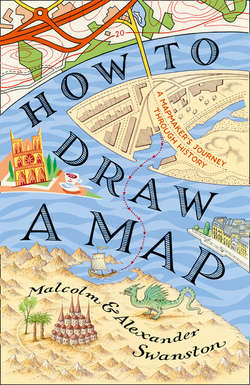Читать книгу How to Draw a Map - Malcolm Swanston - Страница 7
Оглавление1
LOST IN EDEN
The instinct to understand the immediate world around us is not exclusive to humans. Animals create food stores and mark with scent; the honey bee directs its buzzing colleagues to a good supply of nectar, carrying a mental map of their home location. It is, however, the human species who became mapmakers.
Early humans developed a process that psychologists call ‘cognitive mapping’; the ability to process spatial data from the world around us is part of all of us – well, most of us; there are those who still get lost. Getting lost 40,000 years ago was extremely dangerous. A family or clan well understood the nature of their ‘territory’ and that of their neighbours, but beyond that was the vast unknown – and entering the unknown 40 millennia ago was for the brave, desperate or foolhardy.
Despite all the problems of making a journey through an unknown world, modern humans, Homo sapiens, demonstrated their adaptive capabilities and began to spread from Africa 125,000 years ago. Around 40,000 years ago, they began to leave visual descriptions of their experience on rock walls or clay, which represented hills, rivers, animals, dwellings and, of course, themselves. Now, if you were in their shoes, or perhaps moccasins, how would you illustrate your surroundings? Imagine their world and make your marks – what sort of image would you come up with and could it be understood by others? Early man had the same intelligence as today’s, though with an utterly different ‘world’ view. These were the humans who, over thousands of years, migrated and peopled our world. That movement required adaptation to meet the challenges presented by new environments, and there must have been losses because of this movement. Meeting a clan who needed the same resources as your own could, and did, result in warfare, in which losses could be total. Under merciful conditions, the young, fit and healthy survivors might be incorporated into the victors’ clan, perhaps with a reduced social status. We are the descendants of these victors and of the survivors.
Map 2. Homo sapiens, modern humans, began leaving Africa 125,000 years ago. Further waves of migration followed 75,000 and 10,000 years ago.
After first understanding their immediate surroundings, our ancestors also understood the changing seasons and so developed a concept of time, the passing days and, perhaps more importantly, the predictable movements in the night sky. If, in our modern age, you can find a place not polluted by the lights of our civilisation, you might well be overwhelmed by the vastness of your field of vision. The ancients, by experience, will have worked out by the movements of the sun, moon and stars the connection between their position in the sky and the changing of the seasons. And yet, important as it was for the hunter-gatherers to be able to predict the migration of animals and the ripening of various fruits, the emergence of a settled farming lifestyle was perhaps even more critical.
In 1881, working west of Baghdad, then part of the Ottoman Empire, archaeologist Hormuzd Rassam discovered a fragment of a cuneiform clay tablet estimated to be some 4,500 years old. The tablet was uncovered in what was the ancient city of Sippar, now known as Tell Abu Habbah, in what is now Iraq. It was not until the end of the 19th century that the cuneiform script was translated and the significance of this particular tablet, among tens of thousands, was realised. It is the earliest map we have of the world – not just of a locality or neighbourhood, but of the known world. Looking down on a ‘plan’ view of the world, the map shows two concentric circles. The space between the circles is called marratu or ‘salt sea’, an ocean that encircles the world. Within the salt sea is the known world and running through the ‘world’ is a representation that is interpreted as the River Euphrates. The rectangle crossing the river is annotated as Babylon, while there are other symbols labelled as mountains, swamps and canals, and circles to represent important cities and focal points, such as Susa and Urartu.
Map 3. This is the first known world map, created in the 6th century BCE. It attempts to show the known world as seen from Ancient Babylon.
The Babylonians produced many thousands of such tablets, usually depicting local land ownership – which would have been especially useful when organising land use and implementing taxation. Babylonian mathematicians, some 5,000 years ago, divided a circle into 360 equal segments, or degrees, after they had defined the year as approximately 360 days in length, and that calculation has remained in use into modern times. Those mathematical concepts held real value in the ability to make maps.
